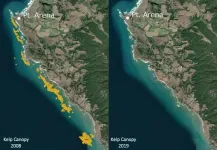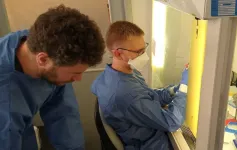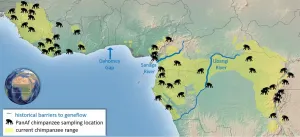(Press-News.org) Satellite imagery shows that the area covered by kelp forests off the coast of Northern California has dropped by more than 95 percent, with just a few small, isolated patches of bull kelp remaining. Species-rich kelp forests have been replaced by "urchin barrens," where purple sea urchins cover a seafloor devoid of kelp and other algae.
A new study led by researchers at UC Santa Cruz documents this dramatic shift in the coastal ecosystem and analyzes the events that caused it. This was not a gradual decline, but an abrupt collapse of the kelp forest ecosystem in the aftermath of unusual ocean warming along the West Coast starting in 2014, part of a series of events that combined to decimate the kelp forests.
Published March 5 in Communications Biology, the study shows that the kelp forests north of San Francisco were resilient to extreme warming events in the past, surviving other strong marine heatwaves and El Niño events. But the loss of a key urchin predator, the sunflower sea star, due to sea star wasting disease left the kelp forests of Northern California without any predators of sea urchins, which are voracious grazers of kelp.
"There were a lot of disruptions at one time that led to this collapse, and the system now persists in this altered state," said first author Meredith McPherson, a graduate student in ocean science at UC Santa Cruz. "It's a naturally dynamic system that has been really resilient to extreme events in the past, but the die-off of sunflower stars caused the resilience of the ecosystem to plummet. As a result, the kelp forests were not able to withstand the effects of the marine heatwave and El Niño event combined with an insurgence of sea urchins."
The researchers used satellite imagery from the U.S. Geological Survey's Landsat missions going back to 1985 to assess historical changes in kelp forest canopy cover.
Bull kelp is the dominant canopy-forming kelp species north of San Francisco Bay, while giant kelp is dominant to the south. Both species thrive when strong upwelling of cold, deep water brings nutrients to the surface along the coast. Marine heatwaves and El Niño events suppress coastal upwelling, resulting in warm water and low nutrient conditions in which kelp grows poorly.
"There have been big changes before, when a strong El Niño has reduced the kelp canopy dramatically, but in the past it's always come back," said coauthor Raphael Kudela, professor and chair of ocean science at UC Santa Cruz. "The loss of resiliency is what made this time different--the combination of ocean warming and the loss of the sea stars allowed the urchins to take over."
Sea star wasting disease first appeared in 2013, affecting all types of sea stars along the West Coast. The sunflower sea star was among the hardest hit species and was recently was listed as critically endangered by the International Union for Conservation of Nature.
Late 2014 saw the advent of an unusual marine heatwave in the Northeast Pacific which became known as "the blob" as it spread down the West Coast in 2015. A strong El Niño event began to develop around the same time, bringing warm water up the coast from the south. The warm water coincided with an increase in sea urchin populations along the North Coast.
"The alignment of all of those events resulted in an incredibly dramatic loss of kelp," Kudela said.
Kelp forests declined all along the California coast, but not to the same extent as in Northern California. Bull kelp is an annual species that regrows each year, which may make it more sensitive to these stressors than giant kelp. But another critical difference in Northern California is the absence of other urchin predators such as sea otters, which have enabled patches of healthy kelp forest to persist in Monterey Bay, for example.
"Sea otters haven't been seen on the North Coast since the 1800s," McPherson said. "From what we observed in the satellite data from the last 35 years, the kelp had been doing well without sea otters as long as we still had sunflower stars. Once they were gone, there were no urchin predators left in the system."
What that means for the future, she said, is that the prospects for recovery of the Northern California kelp forests are poor unless sunflower sea stars or some other urchin predator returns to the system. Even if temperature and nutrient conditions are good for kelp growth, new kelp plants will have a hard time getting established in the midst of the urchin barrens.
There have been some efforts to have divers manually remove urchins from selected areas and see if that can help the kelp to recover, led by the Reef Check California Program (which contributed subtidal survey data for the study). An outbreak of sea urchin disease could also potentially lead to mass mortality of urchins and give the kelp a chance to recover. In the absence of some mechanism to reduce the urchin populations, however, it will be hard to restore and maintain the kelp forests, according to McPherson.
"There's a lot of research and discussion now about the best management strategies for the future," she said. "It's important to understand and monitor the whole system. If we're going to undertake restoration efforts, we need to make sure to do it when the temperature and nutrient conditions are right for the kelp."
Kudela said ocean temperatures are beginning to cool down along the coast, after remaining above normal since 2014. "This year we are finally seeing ocean temperatures starting to cool off, so we're hoping that it reverses naturally and the kelp is able to take off again," he said. "There's really not much we can do except to keep monitoring it. Of course, the long-term solution is to reduce our carbon emissions so we don't have these extreme events."
INFORMATION:
In addition to McPherson and Kudela, the coauthors of the paper include Mark Carr, professor and chair of ecology and evolutionary biology at UC Santa Cruz; Dennis Finger at UC Berkeley; Henry Houskeeper at UC Santa Cruz (now at UCLA); Tom Bell at UC Santa Barbara; and Laura Rogers-Bennett at UC Davis. This work was supported in part by the National Science Foundation.
Quantitative real-time polymerase chain reaction (qPCR) is the most widely used diagnostic method to detect RNA viruses such as SARS-CoV-2. However, it requires expensive laboratory equipment and global shortages of reagents for RNA purification has increased the need to find simple but reliable alternatives. One alternative to the qPCR technology is RT-LAMP (reverse transcription loop-mediated isothermal amplification). This test amplifies the desired target sequences of the virus at a constant temperature, using minimal equipment compared to qPCR. In 2020, it was adapted to the detection of SARS-CoV-2. It was also shown that instead of a swab, which many people find unpleasant, it can be performed on gargle lavage samples.
First author Lukas Bokelmann and colleagues have now ...
Researchers from the Pan African Programme: The Cultured Chimpanzee (PanAf) at the Max Planck Institute for Evolutionary Anthropology (MPI-EVA) and a team of international researchers, collected over 5000 fecal samples from 55 sites in 18 countries across the chimpanzee range over 8 years. This is by far the most complete sampling of the species to date, with a known location of origin for every sample, thus addressing the sampling limitations of previous studies. "Collecting these samples was often a daunting task for our amazing field teams. The chimpanzees were almost all unhabituated to human presence, so it took a lot of patience, skill and luck to find chimpanzee dung at each of the sites," explains ...
Researchers have developed a new quantum version of a 150-year-old thermodynamical thought experiment that could pave the way for the development of quantum heat engines.
Mathematicians from the University of Nottingham have applied new quantum theory to the Gibbs paradox and demonstrated a fundamental difference in the roles of information and control between classical and quantum thermodynamics. Their research has been published today in Nature Communications.
The classical Gibbs paradox led to crucial insights for the development of early thermodynamics and emphasises the need to consider an experimenter's ...
DUBLIN, Friday, 5 March 2021: RCSI researchers have discovered a new way to 'put the brakes' on excessive inflammation by regulating a type of white blood cell that is critical for our immune system.
The discovery has the potential to protect the body from unchecked damage caused by inflammatory diseases.
The paper, led by researchers at RCSI University of Medicine and Health Sciences, is published in Nature Communications.
When immune cells (white blood cells) in our body called macrophages are exposed to potent infectious agents, powerful inflammatory proteins ...
New York, NY (March 5, 2021) - Overweight children who were exposed to lead in utero and during their first weeks of life have the potential for poorer kidney function in adulthood, according to an Icahn School of Medicine at Mount Sinai study published in Environment International in March.
The study found that children with high body mass indexes who had been exposed to lead had lower estimated glomerular filtration rate (eGFR), a measure of how well the kidneys are filtering or cleaning the blood. The researchers measured blood levels during mothers' pregnancy and later measured eGFR levels in the children when they were between 8 and 12 years old.
Decreased ...
Researchers have succeeded in making an AI understand our subjective notions of what makes faces attractive. The device demonstrated this knowledge by its ability to create new portraits on its own that were tailored to be found personally attractive to individuals. The results can be utilised, for example, in modelling preferences and decision-making as well as potentially identifying unconscious attitudes.
Researchers at the University of Helsinki and University of Copenhagen investigated whether a computer would be able to identify the facial features we consider attractive and, based on this, create new images matching our criteria. The researchers used artificial intelligence to interpret brain signals and combined the resulting brain-computer interface with a ...
Researchers from University of Houston and University of Bochum published a new paper in the Journal of Marketing that examines how variable compensation plans for salespeople can lead to lower health.
The study, forthcoming in the Journal of Marketing, is titled "Variable Compensation and Salesperson Health" and is authored by Johannes Habel, Sascha Alavi, and Kim Linsenmayer.
Sales compensation plans typically comprise a variable component. Variable compensation is issued on top of a base salary and the amount is contingent on performance. For example, a salesperson with an annual target salary ...
New research published in Diabetologia (the journal of the European Association for the Study of Diabetes [EASD]) shows that regular physical activity is a safe diabetes prevention strategy for people residing in relatively polluted regions.
The study, which is the first to investigate the combined effects of physical activity and pollution exposure on type 2 diabetes risk, is by Dr Cui Guo and Professor Lao Xiang Qian, Faculty of Medicine at the Chinese University of Hong Kong, Hong Kong SAR, China, and Dr Hsiao Ting Yang, Institute for Risk Assessment Sciences, Utrecht University, Utrecht, the Netherlands, and colleagues.
An increasing body of evidence has shown that air pollution ...
A series of weekend workshops that integrate strategies for both reducing risky alcohol use and preventing sexually transmitted infections (STIs) led to an increase in safe sex and decrease in drinking among young Black women, according to a new study published in the American Journal of Preventive Medicine.
"By designing an intervention that didn't treat sex and alcohol use as two separate risk factors, young women were empowered to make healthier decisions and better communicate with their partners," said Ralph DiClemente, professor and chair of the Department of Social and Behavioral Sciences at NYU School of Global Public Health and the study's lead author.
"This groundbreaking study illustrates ...
Columbia researchers engineer first technique to exploit the tunable symmetry of 2D materials for nonlinear optical applications, including laser, optical spectroscopy, imaging, and metrology systems, as well as next-generation optical quantum information processing and computing.
New York, NY--March 4, 2021--Nonlinear optics, a study of how light interacts with matter, is critical to many photonic applications, from the green laser pointers we're all familiar with to intense broadband (white) light sources for quantum photonics that enable optical quantum computing, super-resolution imaging, optical sensing and ranging, and more. Through nonlinear optics, researchers are discovering new ways to use light, from getting a closer look at ultrafast processes in physics, ...






